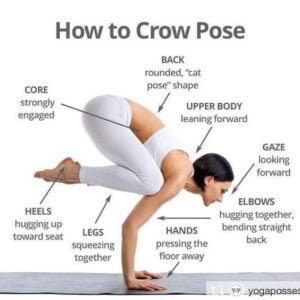Kakasana (Crow Pose) : Analysing the postures with knowledge from the muscular and skeletal system
Note: I am not extremely familiar with the muscular and skeletal system so some muscles/bones pointed out MAY be wrong!

(Taken from Pinterest)
To get into Kakasana, yoga practitioners need to ensure first that their arms are able to hold the body weight. This involves activating the triceps brachii and biceps brachii to provide a strong base to rest the body weight upon. Contracting the deltoid muscles (anterior, medialis, posterior), pectoralis major muscle and trapezius muscle will also provide additional support to the arms to bear the weight. As the practitioner leans forward, he/she increasingly activates and contracts the serratus anterior muscle and psoas muscles (iliopsoas and iliacus) to keep the body lifted up and able to rest on the arms for a sustained period of time. To a certain extent, in order to bring the feet together to touch, there is a need to contract the adductor muscles (brevis and longus) to bring the feet closer together, and the tibialis posterior and extensor digitorium to point the toes.
As this is an arm balance posture, the areas with the greatest points of contact with the ground, and thus bearing the most weight are the hands – the tips of the fingers (phalanges), and especially the carpals. Practitioners whose arms and psoas muscles are not properly activated for the posture will end up bearing more weight on their wrists and potentially put strain on the wrist area.

